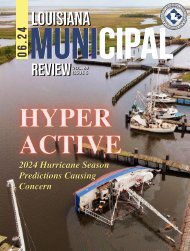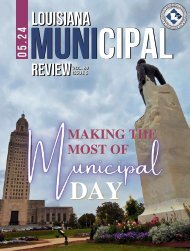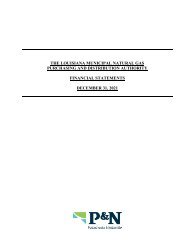October 2023
You also want an ePaper? Increase the reach of your titles
YUMPU automatically turns print PDFs into web optimized ePapers that Google loves.
for our Sportsman’s Paradise – namely<br />
a shift in seeing evacuations take place<br />
in more inland areas of the state. Could<br />
that be a new normal for many municipalities?<br />
“Evacuations and moving people to a<br />
safe area should be a practice and something<br />
municipalities plan for, because<br />
yes, this is the new normal. We only<br />
need to think about a hazardous materials<br />
release or an active shooter situation<br />
to see that. We should always be aware<br />
of our surroundings. Just as you need<br />
two ways out of a building, you should<br />
also have two ways out of a municipality<br />
in case of an emergency,” said Browning.<br />
I harped on training earlier, so let’s revisit<br />
that. The Department of Agriculture<br />
and Forestry boasts a Forest Protection<br />
Branch that “regularly conducts training<br />
programs for the agency’s fire crews,<br />
stressing safe and effective firefighting<br />
techniques. The agency also has the<br />
cooperation of the U.S. Forest Service,<br />
whose crews may support and back up<br />
the Office of Forestry’s fire suppression<br />
crews during extreme fire conditions.<br />
The specific objective of the branch is to<br />
keep the annual percent of burn at a level<br />
of no more than 0.25 of one percent<br />
(one-fourth acre for each 100 acres protected)<br />
in each parish in the intensively<br />
protected mixed pine areas of, primarily,<br />
north Louisiana parishes and to keep<br />
the annual burn at a level of no more<br />
than 0.50 of one percent (one half acre<br />
for each 100 acres protected) in flash<br />
fuel areas,<br />
primarily in<br />
southeast<br />
and southwest<br />
Louisiana.<br />
Overall,<br />
the aim is<br />
to hold the<br />
average size<br />
per fire to<br />
less than<br />
13.2 acres.<br />
James LeBlanc Records indicate<br />
that in 2016, the average size of<br />
Louisiana’s forest fires was 10.45 acres.”<br />
So, how does the role of a volunteer<br />
firefighter play into this in terms of that<br />
training? People tend to forget that in<br />
Louisiana, a vast number of our fires<br />
are being fought by volunteers. Many<br />
municipalities in our more rural regions<br />
of the state don’t have the funding for<br />
full-time fire departments, so they rely<br />
on the kindness and dedication of men<br />
and women willing to chip in and lend<br />
a hand when called upon. Well, those<br />
volunteers don’t always have what they<br />
need, and they are exhausted. That lack<br />
of training and resources, coupled with<br />
that exhaustion, can impact the abilities<br />
of people being called to tackle house<br />
fires or arson blazes when their time is<br />
taken up with wildfires. St. Amant Volunteer<br />
Fire Chief James LeBlanc explains.<br />
“Many times, while fighting the wildland<br />
fires here in Ascension Parish, we realized<br />
that Mother Nature was in the driver’s<br />
seat. Our volunteers worked so hard<br />
to make sure we were not in her way<br />
LMR | OCTOBER <strong>2023</strong> Page 11
















